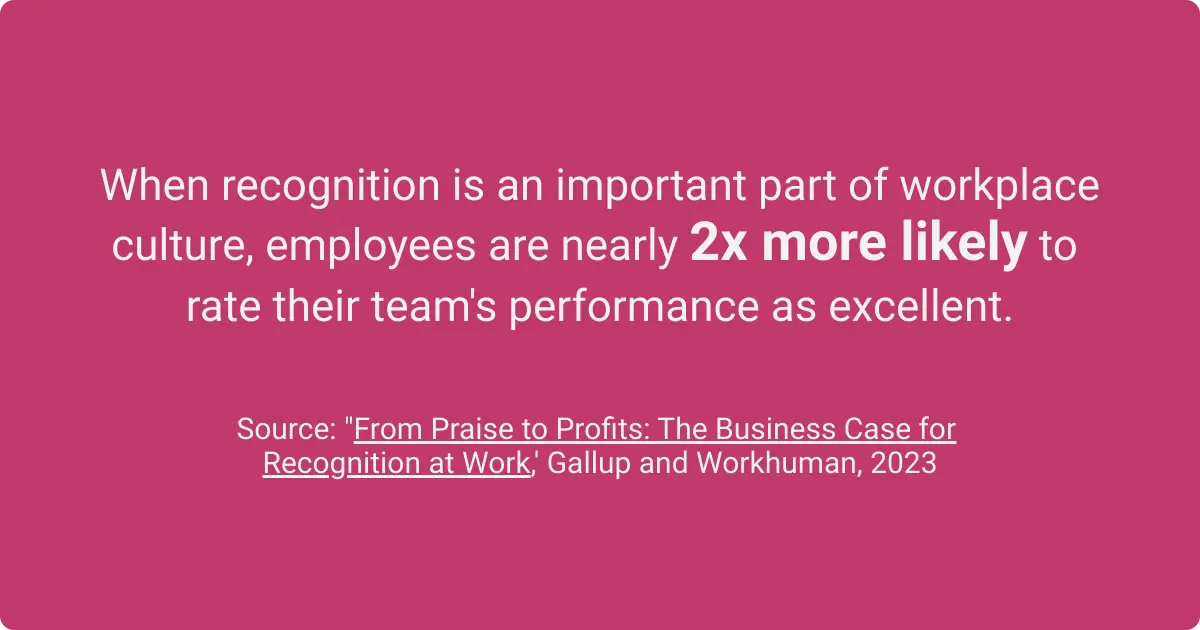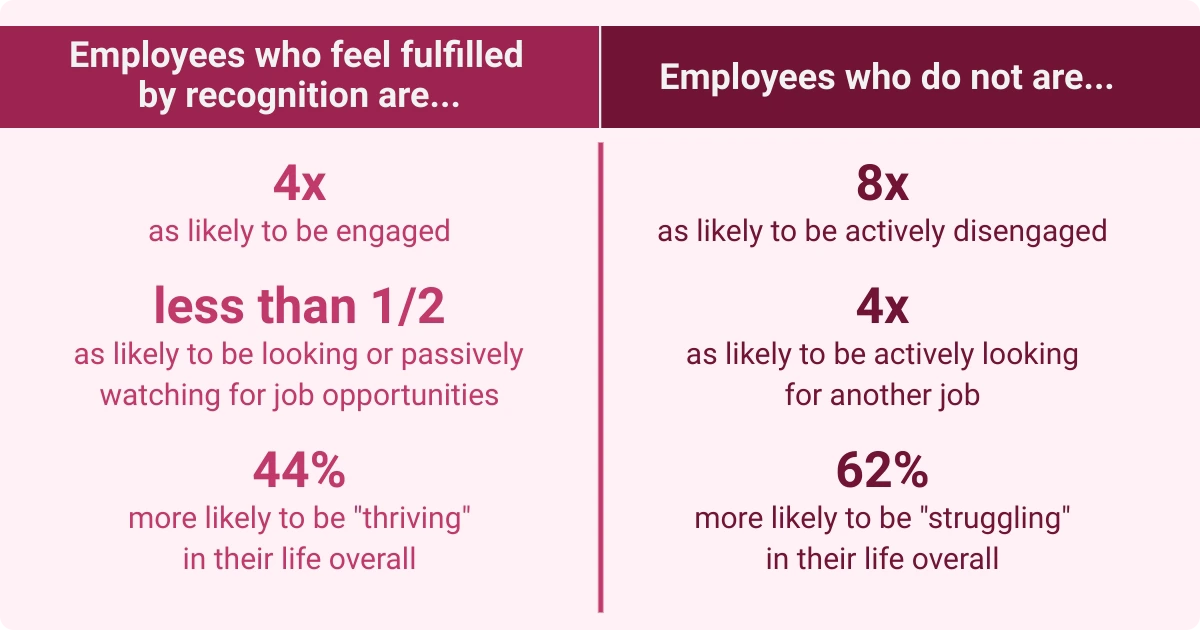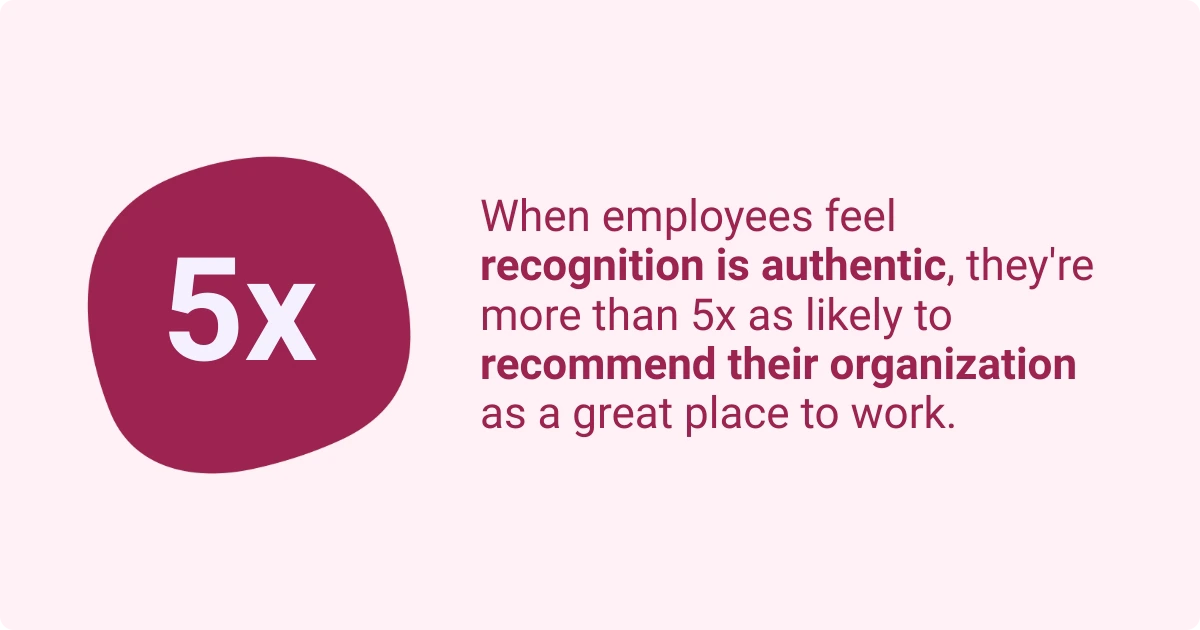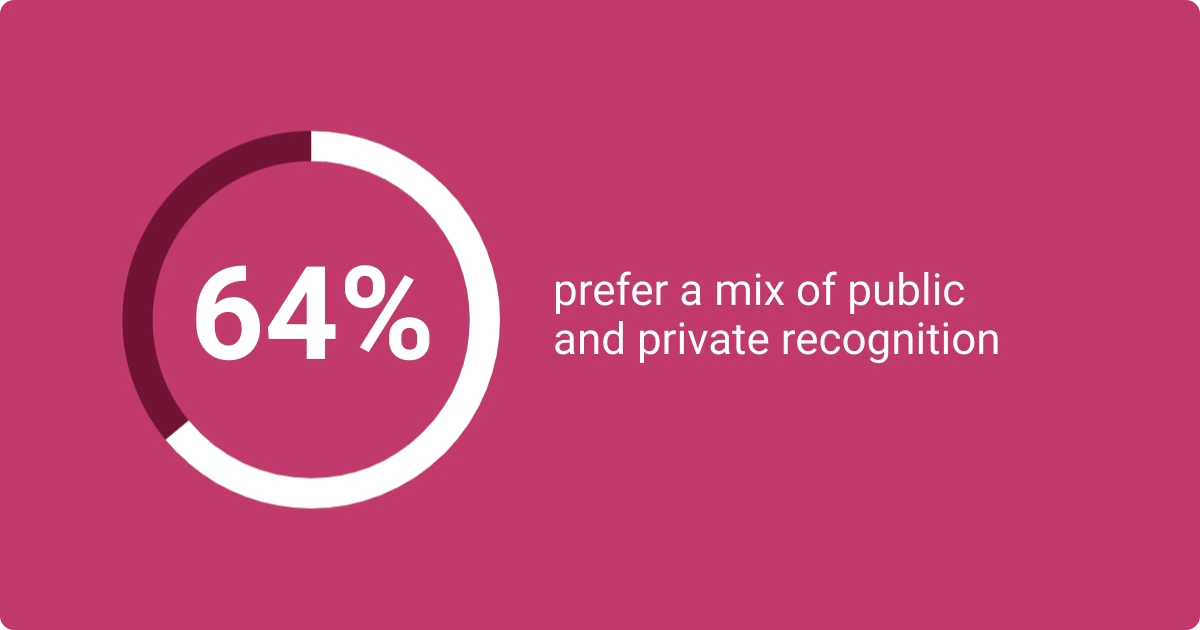Utilizing Measurable Employee Recognition Criteria to Transform Your Workplace

Recognition in the workplace is capable of transforming an organization. A new study from Gallup and Workhuman®, “Unleashing the Human Element at Work: Transforming Workplaces Through Recognition,” shows recognition improves multiple facets of the employee experience. Using measurable employee recognition criteria to track the success of your program can help create a culture where:
- 73% less likely to “always” or “very often” feel burned out
- 56% less likely to be looking for a new job
- 5x as likely to feel connected to their culture
- 4x as likely to be engaged
- 5x as likely to see a path to grow at their organization
- 4x as likely to recommend their organization to friends and family
- 44% more likely to be thriving in their life overall
Are you ready to transform your workplace with a human-centric approach? Discover strategies and tactics to strengthen connections and build a culture of recognition in your organization.
Embrace celebrations that honor the whole human and recognition that flows up, down, and across your company. Set the path for a brighter future of work with a human-centric approach.
Click the link to download the report now!
Referrals, engagement, well-being, connection, growth, employee turnover, and work-life harmony – employee recognition dramatically boosts the employee experience in and out of the office. And not just a short-term bump: these are areas that can sustain themselves for years.
The caveat is that these results are contingent on well-functioning employee recognition, and there’s no guarantee of a successful recognition program right out of the proverbial box. It will likely require tinkering and evolution, processes that are only possible when you know how to measure the success of the program.
Why should you measure your recognition program?
Measuring success – and continued success at that – becomes even more important when time, energy, and money are on the line.
You recently instituted an employee recognition program at your organization. Are employees happier, more engaged, more connected, and no longer bolting for the exits?
Recognition programs also provide authentic and valuable insights into how employees work and where they thrive. With Workhuman iQ & AI Assistant you can mine your program data and return unparalleled insight into people dynamics, culture, skills, and more.
Workhuman iQ can transform your understanding of the employee experience with AI-powered social analytics to unlock data-driven strategy. It's the kind of intel you’ve always wanted, delivered in a way that anyone can use.
Everyone – leaders, managers, and employees – benefits when a recognition program is clicking. But it’s only when you understand how and why it’s clicking that you’ll be able to sustain that success.
Our new AI Assistant was built on 25+ years of recognition research, case studies, and best practices to proactively coach you to monitor and improve the effectiveness of your recognition program.
How do you create criteria for employee rewards?
Create criteria for employee rewards that align with the goals of the program. Are employees meeting and collaborating more? Are pulse surveys getting more responses? Are moments of recognition increasing? Are safety incidents on the decline? Are there more work anniversaries or exit interviews?
Employee morale, engagement, and connection can appear intangible. But with a recognition program that allows employees to express and easily communicate gratitude for all to see, you’ll quickly find tangible measures of growth.
Eleven measurable criteria for employee recognition
Length of service
If you want people to want to stay at your company, celebrating work anniversaries is an easy place to start. This reward strengthens the sense of connection and community. You should consider increasingly larger rewards for each year of tenure. Some examples are as follows:
- Award long-term employees with special milestones. For example, giving employees the opportunity for a lengthy sabbatical after five years of service.
- Offering loyalty bonuses or extra vacation days after a certain number of years.
Personal and team accomplishments
Engagement, productivity, and collaboration are pillars of a thriving workplace. Acknowledge the hard work and successes of those responsible. And don’t feel you need to wait until the end of the project to celebrate. Clearing hurdles and powering through difficult stretches are worthy of recognition, too. Some things to celebrate may be:
- Leading a successful, high-impact project or campaign.
- Exceeding sales targets as an individual or team.

Demonstrations of leadership
Setting a good example, stepping up when needed, or helping out wherever is required are traits and behaviors you want to be contagious. If they’re recognized, they’re more likely to be duplicated. This is an area where recognition can be deployed as a coaching technique to encourage more of what you want to see.
- Resolving conflicts within the team effectively.
- Mentoring younger employees or cross-training employees with different skill sets.
- Effectively leading engaging team meetings.
Work safety
Employee engagement takes on a whole new meaning when injuries are a risk in the workplace. Creative employee recognition ideas can keep people motivated and, more importantly, attentive, which can have a big impact on safety incidents. Things to celebrate can be:
- Reporting potential safety hazards to senior leadership.
- Maintaining a quality safety record as an individual or a team.
- Completing supplemental safety training.
Innovative thinking
In a psychologically safe workplace, employees are emboldened to propose big, new ideas and, in some cases, bring them to life. Celebrate success in the workplace. These are the efforts that elevate the entire company, such as:
- Proposing a process change to improve efficiency and workflows.
- Automating a task to save time and resources.
- Generating creative solutions to problems or new campaign ideas.
Now that you know what you can measure, let’s look at how you can measure. A recognition program should provide you with a host of engagement analytics – from recognition frequency to the reach of recognition. These will help you set benchmarks, allocate a budget for continued investment, and determine success or shortcomings.
These don’t need to be measured daily, but a regular cadence (read more than once per year) will allow you to keep a pulse on employees and address issues in a more timely manner.
Here are some KPIs to consider when measuring the ROI of your recognition program.
Program adoption
For an employee recognition program to be successful, employees need to, you know, use it. Chances are, they will all use it a little differently. Measure the frequency and reach of recognition to get a sense of how the program is used and if there are gaps or discrepancies in reward distribution.
- Recognize teams that are early adopters of company initiatives.
- Reward individuals or teams that consistently use and engage with new platforms or programs.
Award threshold
Helping someone with a project for an hour and securing a huge client are both good. However, award levels will vary based on the scale of the task. If only certain tiers are being used, it might be time to revisit them or encourage new avenues for employees to recognize. Some examples may be:
- A certain number of recognition points or a small monetary bonus for success on a small project.
- A larger number of recognition points or a larger monetary bonus for a year-long campaign or projects with larger-scale impact.
Equitable rewards
A successful corporate rewards program is an equitable one. Rewards should be distributed fairly and unbiased across every measure: age, race, gender, and seniority. This is one of the most important areas to measure, as it requires immediate course correction. You should consider:
- Assessing the distribution of awards by gender, race, sexual orientation, seniority, department, etc.
- Utilizing inclusive tools such as Workhuman AI to make sure award messaging is inclusive.
Employee engagement scores
Employee engagement scores can be used to measure an employee’s level of involvement in company culture, degree of commitment to the organization, and overall job satisfaction. Employees with higher engagement tend to be “culture carriers” and forces of good within the organization, and they deserve to be recognized and praised for their efforts. Laudable behaviors related to these scores might include:
- Participation in non-mandatory team-building activities.
- Making an effort to celebrate other employees’ life events and successes, contributing to a positive company culture.
- Working to create positive personal and professional connections with direct reports, managers, and peers.
Teamwork
An employee’s skills in teamwork and collaboration can be measured through feedback from their peers, the success of shared projects, and the way they speak to their colleagues, both in person and in writing. Employees who make a concerted effort to contribute to a positive team dynamic and work hard to achieve shared goals deserve to be recognized for their efforts. Some examples of this type of work ethic may include:
- Helping team members to meet project deadlines by offering support and assistance.
- Mediating interpersonal conflicts with grace.
- Speaking kindly to their coworkers, even when giving difficult feedback or discussing mistakes.
Professional development
Upskilling, earning new certifications, going back to school, or showing initiative for growth in a variety of other ways are all commendable actions. Recognizing employees for pursuing these learning opportunities and applying new skills can be a powerful way to show your entire staff how much you value growth and development. Some behaviors to recognize might include:
- Starting or participating in a mentorship program.
- Taking a digital course to learn a new skill.
- Attending leadership workshops and conferences.
Why are employee recognition programs important?
Employee recognition programs can have far-reaching positive effects on a company’s culture. These gratitude programs can help employees feel seen and appreciated and motivate them to continue working diligently. By calling out their unique skills and strengths, these programs can also contribute greatly to confidence-building.
Recognition programs can help improve employees’ productivity and engagement. They can also enhance team bonding as peers, employees, and leaders all have the opportunity to reward one another.
All of these elements can help bolster an employee’s sense of psychological safety, which can, in turn, increase their desire to stay at the company for a longer period of time, decreasing turnover rates.
How to help your recognition program succeed
You can help your program in a lot of easy ways. Make sure people know how to use it, encourage participation, get leadership buy-in, and make it easy.
In our research with Gallup, we found that all recognition is good, but we identified five pillars that are critical to its success. Recognition should be fulfilling, authentic, equitable, embedded in the culture, and personalized.
Fulfilling recognition
There’s no “magic number” for how many times to recognize someone. Most employees want to be recognized a few times per month, but organizations should view that as a bare minimum. There’s no such thing as too much recognition so long as it’s “genuine and appropriately given.” Fulfilling recognition validates the effort and appreciates the value added.

Authentic recognition
Even if you give the right amount of recognition, if it’s accompanied by empty words, it can undermine the experience. Recognizing employees becomes more meaningful when there is a clear reason for it. Tying recognition to specific achievements and goals can help, as can spontaneous, in-the-moment feedback.
When employees feel recognition is authentic, they’re more than 5x likely to see a path to grow in the organization, 6x more likely to agree their organization cares about their well-being, and 5x as likely to recommend their organization as a great place to work.
Authentic recognition is especially meaningful for Black and Hispanic employees. When they strongly agree the recognition they get is authentic, they are 79% and 69% more likely to be thriving, respectively. Sentiment matters.

Equitable recognition
When employees see recognition that is out of balance – particularly if they feel shorted – it sets off an alarm to the need for fairness and ends up damaging their experience.
Right now, the alarms are blaring. Only about 26% of employees strongly agree they receive equitable recognition. For Hispanic employees, that drops to 21%, and for Black employees, it drops again to 19%.
Recognition can reflect the state of inclusivity and equity at an organization, or it can reveal underlying attitudes and biases that have longtail repercussions. A general lack of perceived equity in recognition signals that credit isn’t being given where it’s due, and that’s a serious failure.
Recognition embedded in the culture
Simply having a recognition program isn’t enough to reap the benefits and see the change it’s capable of. For that, it needs to be part of a continuous recognition culture. One where gratitude, praise, and appreciation are freely given, frequently received, and far-reaching to every corner of the organization.
Thirty-six percent of employees report having recognition programs in place at their company, but only 19% of them strongly agree that recognition is embedded in the organization.
48% of employees rarely hear 'thank you.' It’s time to change that. Discover 3 strategies to build a recognition culture that empowers and inspires your team.
A culture of recognition affects the totality of an employee’s experience. At full strength, it will embolden everyone to participate in celebrating success and showing appreciation. One way to help it take root is to make recognition public. Widely viewed recognition is a culture booster and encourages more participation.
Personalized recognition
Just like the right amount of recognition varies depending on the employee, so too do preferences for how and where recognition is received. Twenty-nine percent of employees prefer recognition in private, 7% prefer it in public, and 64% prefer a mix.
It can seem like getting recognition “right” is a moving target, but here’s how to ensure a bullseye: ask them. Understanding how an employee responds best to recognition helps you tailor an authentic experience for them.
Technology affords various channels to communicate recognition to balance public recognition with something more private for those who prefer it. Mentioning good work in an email chain, expressing appreciation on an online recognition platform, and forwarding kind and positive comments to superiors (or even from superiors) are all forms of public recognition that will land differently for every employee.

Integrating recognition
This is a bonus pillar. Integrating recognition technology with the tools and services employees use every day – programs like Slack, Outlook, Workday, Teams, and Yammer – keeps it consistently within reach.
These programs are some of the most effective ways for employees to connect with one another, especially in hybrid and remote work. By integrating with each of these solutions, you can inject the human connection into common, ongoing workflows. Making it as easy to use and navigate as possible is a surefire strategy for improving adoption.
Investing in recognition
Consider this the foundation that all the pillars (even the bonus pillar) rest on. Investing time and funding are critical to the success of an employee recognition program.
Despite existing research showing that recognition can improve business outcomes, 81% of leaders say recognition is not a major strategic priority in the organization, 64% say there is no budget allocated specifically to recognition, and 73% say their organization does not provide any best-practice training for employee recognition.
When leaders and managers aren’t given the necessary resources and knowledge for recognizing people, when they’re not provided with the outlets, programs, and systems for conferring recognition, and when they’re not even recognized themselves, the program is doomed to fail.
Investment requires financial and human capital. It needs funding, yes, for it to truly make an impact. But it requires effort on behalf of everyone, especially the most senior leaders who have the power to provide guidance and set the tone for everyone else. When organizations invest in recognition, it sends a clear message to employees about what they prioritize and value.
FAQs
What are the five pillars of recognition?
A successful recognition program is fulfilling, authentic, equitable, personalized, and embedded in company culture. Ensuring that your recognition program has all five pillars will help it be more impactful and successful.
What is a recognition strategy?
A recognition strategy is a specific, purposeful, goal-oriented plan to improve an organization’s culture by thanking employees for their hard work and unique contributions. Recognition strategies should be tailored to fit your company’s values, as well as your employees’ needs and preferences.
What type of recognition and rewards do employees prefer?
There are no universal “rules” about which recognition strategies are most effective. Some employees prefer to be recognized privately, while others enjoy the feeling of being celebrated publicly. However, having rewards attached to recognition often helps employees feel truly valued, especially when those rewards have a direct monetary component.
Conclusion
Using specific, measurable employee recognition criteria can help you measure the efficacy of your company’s recognition program.
It’s also important to remember that the success of employee recognition doesn’t hinge on any one person. Ideally, visualizing the collective moments of recognition – peer-to-peer, cross-team, and company-wide – should look like an interconnected web spanning dozens of directions. That shape is deeply connected to a more positive, productive, and inclusive company culture.
About the author
Anna Picagli
As an RYT500 yoga instructor and a Reiki Master Teacher, Anna is an advocate for holistic wellness, especially within the workplace. She’s extremely passionate about the brain-body connection and exploring how mental and physical wellness intersect.
Anna has experienced firsthand how chronic stress, overworking, poor management, and other organizational issues can lead to extreme burnout. Knowing the impact that a toxic work environment can have on a person’s body, psyche, and general sense of well-being, she now works to direct others away from facing the same fate.
As Workhuman’s Senior Content Specialist, Anna is a regular contributor to Workhuman iQ reports and aims to create resources that company leaders can reference to help improve their culture and empower their employees, creating healthier workplaces for everyone.
In her free time, she’s an avid solo traveler, a voracious reader, and a seasoned home chef. You can learn more about Anna’s work on LinkedIn or through the Yoga Alliance.